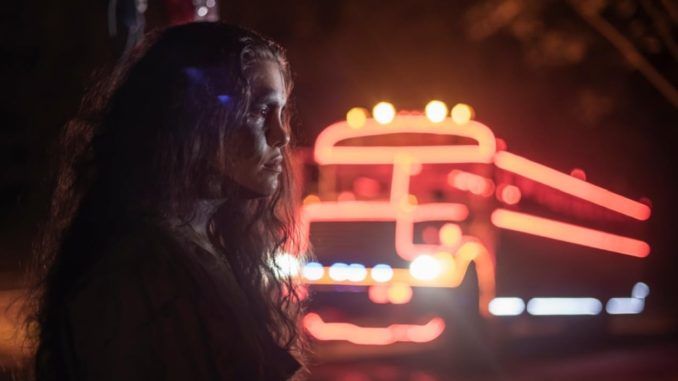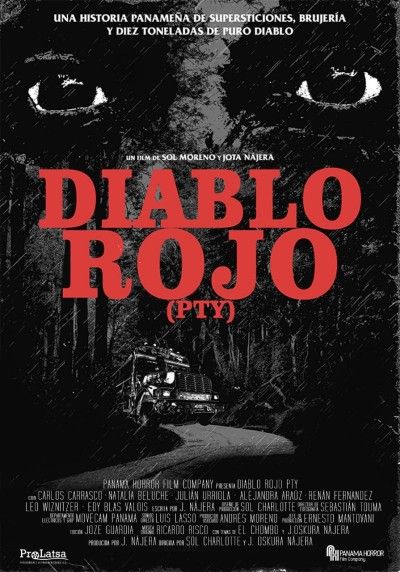
Rating: B
Dir: Sol Charlotte, J. Oskura Nájera
Star: Carlos Carrasco, Leo Wiznitzer, Alejandra Araúz, Julian Urriola
We kick off our annual celebration of all things horror, with what is reported to be the first film in the genre out of Panama. It’s a place previously only in my consciousness for the canal. You wouldn’t know there was such a lack of horror experience in the country. While this is occasionally rough in the detailed execution, the obvious energy in it goes a long way. I also came away knowing more about the place than I did going in. Specifically, knowing more about the public transport situation in its capital. That is certainly not knowledge I expected to pick up. It’s like watching a giallo and being educated about how Italian railway timetables are laid out.
The title translates as “red devil,” something even my Duolingo-level Spanish figured out. I’m not sure about the “PTY” on the end. It’s the IATA code for the local airport. Probably not relevant. Might be the local version of “Ltd.”? Unsure. What it refers to, in any case, are hordes of brightly painted and garishly decorated private buses – mostly repurposed American school transport. For decades, these formed a public travel network in Panama City. Thoroughly unregulated, they had a reputation for bad driving, and general danger. But with a flat fare of 25 cents, you couldn’t argue with the price. From what I’ve Googled, the diablo rojo were replaced with city-run buses in 2013, so despite references to selfies and social media, I’m not sure if that means the movie takes place before then.
 For the central character here is Miguel Moreno (Carrasco). He owns and drives a diablo rojo round the streets, with Junito (Urriola), his conductor, racing rival buses for passengers. At the end of the day, they’re enjoying a beer, when Miguel has to take a leak. But in the process, he is accosted by a woman… who after a quick snog, transforms into a creature and attacks him. Understandably shook, he and Junito depart in the bus, at a speed which attracts the attention of two highway patrol officers. The pursuit is only ended when Miguel slams on the brakes because there is another woman standing in the middle of the country road on which he finds himself. She transforms similarly, biting one of the cops on the hand.
For the central character here is Miguel Moreno (Carrasco). He owns and drives a diablo rojo round the streets, with Junito (Urriola), his conductor, racing rival buses for passengers. At the end of the day, they’re enjoying a beer, when Miguel has to take a leak. But in the process, he is accosted by a woman… who after a quick snog, transforms into a creature and attacks him. Understandably shook, he and Junito depart in the bus, at a speed which attracts the attention of two highway patrol officers. The pursuit is only ended when Miguel slams on the brakes because there is another woman standing in the middle of the country road on which he finds himself. She transforms similarly, biting one of the cops on the hand.
Low on petrol, they seek help in a nearby church run by Padre Andres (Wiznitzer). There, they discover several unsettling things. The time has stopped at midnight. They are, somehow, several hundred miles from the capital. And it’s not just chance they showed up on this priest’s porch. During a refuelling stop, he recognizes the woman painted on the side of Miguel’s vehicle. It’s Josefina Becerra (Araúz), the driver’s first love, whom he had to abandon when he moved to the city, more than three decades ago. Andres can now fill in the rest of the story, and what then happened, isn’t pretty. Josefina was pregnant, to her family’s horror. After giving birth, she committed suicide, and the baby was never found. Revenge, it seems, is best served 33 years later.
Time for more education. This is based on a local legend, La Tulivieja. Per Wikipedia, she was a woman who had a baby out of wedlock, “drowned the child in a river, and was punished by God transforming her into a hideous creature. She is a short woman with a thick body, swollen breasts, sometimes leaking milk, and tangled hair.” Here, the child survives, but is found and raised by a coven of witches, being trained in the dark arts. It’s now time for her to graduate from Sorceress Academy. Fortunately for the men, having a priest on their side is helpful, since holy water is among the effective deterrents. So is weed, much to Junito’s delight.
A crisp seventy-seven minutes, there’s a lot going on. The film does a good job of keeping things moving forward in the present, while also filling in the backstory. As if the witches weren’t enough threat, the region of the country is also home to cannibalistic tribesmen. This angle isn’t well developed though, and the makers would probably have been better off sticking to the main enemies. The opening theme music did feel as if it had strayed in from an eighties cannibal movie, again leaning into the possible period setting. But it’s mostly witches vs. the patriarchy, with the former clearly a brutal threat, who can not be reasoned or bargained with.
 Mentioning that, it is interesting how there’s apparently a strict gender line in play: all the protagonists are male, while the witches are all women. At least, it appears so; most of this takes place at night, and who am I to assume the gender of witc… er, honoured practitioners of wicca. Well, except for the “baby sacrifice” thing. Such alternative religious practices might be a bit problematic, even in California. That said, you can see why Josefina is pissed off. Society didn’t exactly treat her well, and blaming Miguel makes sense from her perspective. On the other hand, he had a decent justification for leaving, and had no clue about her pregnancy when he departed.
Mentioning that, it is interesting how there’s apparently a strict gender line in play: all the protagonists are male, while the witches are all women. At least, it appears so; most of this takes place at night, and who am I to assume the gender of witc… er, honoured practitioners of wicca. Well, except for the “baby sacrifice” thing. Such alternative religious practices might be a bit problematic, even in California. That said, you can see why Josefina is pissed off. Society didn’t exactly treat her well, and blaming Miguel makes sense from her perspective. On the other hand, he had a decent justification for leaving, and had no clue about her pregnancy when he departed.
The effects are, to be fair, a bit of a mixed bag. While most are nicely practical, sometimes they do go further than what the resources available can support. Still, there’s a “can do” attitude which shines through at all times, and is highly admirable. I was reminded of The Evil Dead in the way this constantly proves that money is not necessary to achieve a director’s vision. The ending, in particular, is just lovely. It’s one of the best “ah-ha!” moments I’ve seen in a horror movie, where pieces set up previously suddenly click into place, to provide a near-perfect resolution. While you might not want to travel to Panama after seeing this, you may want to see more Panamanian horror.
This review is part of our October 2024 feature, 31 More Countries of Horror.
